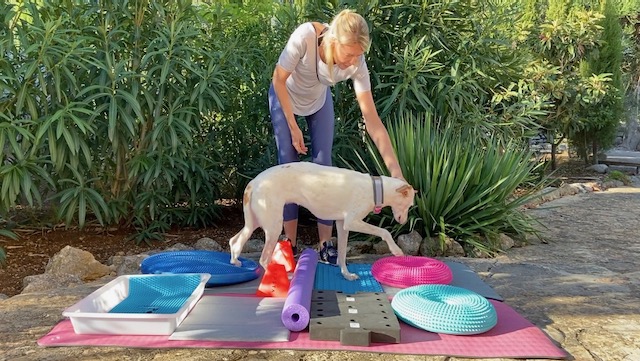Proprioception in dogs – have you ever heard of it? Behind the complicated word proprioception lies the depth sensitivity and self-awareness of the body. In detail, this means the perception of one’s own body according to the position in space and the individual body parts in relation to each other. That is, how the head, torso, arms and legs are arranged in relation to each other. But also the change of position of the body parts in the movement of the body. It also includes the sensation of body tension, power, speed and heaviness. A whole lot, then.
What is proprioception important for in dogs?
There are many dogs that have a decidedly poor self-awareness of the body. They are true artists at stumbling, sprawling, and misjudging movements.
So good proprioception is extremely important in dog life. It helps ensure that our dogs move safely and perceive their position in space correctly. This avoids injuries in everyday life, but also in sports. Jumps, for example, are executed much more precisely with good body awareness.
What can disrupt proprioception?
For example, with neurological conditions such as a herniated disc or cauda equina compression syndrome, dogs often have very poor body sensation because nerve function is damaged and restricted. Proprioception can also be disrupted after injury.
How to train the dog’s proprioception?
In addition to coordination and body awareness, proprioceptive training also trains the speed and accuracy of the execution of a movement – in other words, fine motor skills. This not only protects against injuries in everyday life and sports, but also promotes the performance and concentration of the dog. With the help of proprioceptive training, dogs become more confident and stand physically and mentally with four paws firmly in life.
Ideas for training proprioception in your dog
By having the dog walk slowly and deliberately over different surfaces, uneven ground or unstable surfaces, the proprioceptors are activated. There are several options for training.
Different surfaces – the proprioceptive course
Here the dog must move as slowly as possible with targeted movements over various surfaces. You can assemble and vary the components of the proprioceptive bar yourself. Sand, corks and pebbles can be deposited in shallow wooden trays.
Ideas for the course:
- Sand
- Cork
- Pebble (or mosaic tiles with pebble structure)
- Artificial turf
- Rubber mat
Training on unstable surfaces
Unstable surfaces also train fine motor skills. Also, your dog needs to balance himself.
Ideas for unstable surfaces:
- Wobble board
- Trampoline
- Foam
- (Air) mattress
Here you lead your dog slowly over the (air) mattress or foam, or linger for a moment. You can also stand on it yourself and move slightly so your dog has to balance.

With the trampoline or wobble board, you lead the dog on it and can stand with on the equipment and shift his weight slightly so that the dog has to react accordingly. Small impulses are also quite sufficient here.
On the walk
Even on the daily walk there are many opportunities to train fine motor skills in addition to coordination and body awareness:
- Mowed fields
- Forest floor with small roots
- Sandy soil
- Pebble path
- Lead the dog over branches of different thickness
- Lead the dog around tree stumps

Lead your dog here in the step over the different undergrounds. In order for you to control the pace well, it is recommended that you lead your dog on a leash. Keep the sessions of the workout short and vary the surfaces more frequently to avoid a habit effect.
In addition, many exercises from active movement training, such as cavaletti training, slalom running, etc., have a positive effect on the dog’s proprioception.
The most important thing when doing proprioceptive training with your dog is, above all, that your dog always moves as deliberately and slowly as possible. The surface should always be non-slip and the tasks solvable for your dog. Never force your dog to do an exercise he is not comfortable with. What may seem less than spectacular to us can be quite a challenge for your dog. Give him enough time and show patience. Your dog should have the opportunity to work out and experience movements and surfaces at his own pace.
By the way: You can also find these and many more exercises in my online courses on fitness and exercise training for dogs!
All the love, your Tina
Dieser Beitrag ist auch verfügbar auf:
Français (French)
Deutsch (German)
Español (Spanish)















